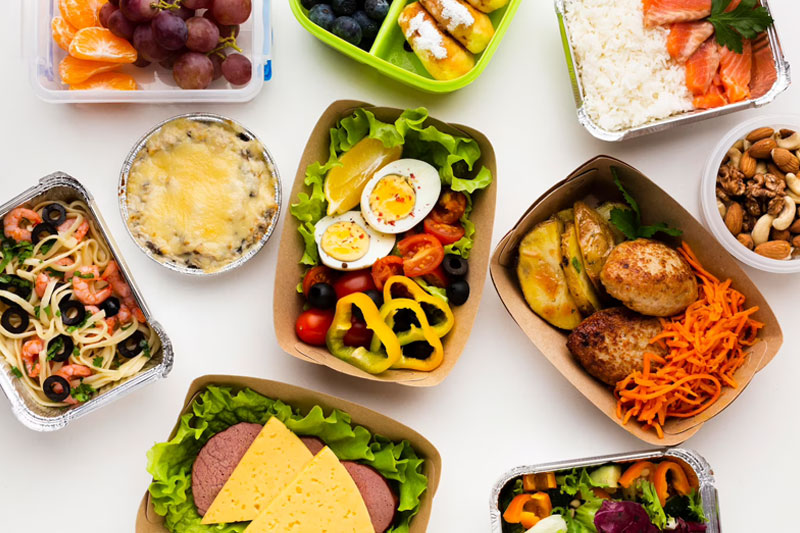Do you like the idea of a flexible eating plan that keeps your gut happy and helps you stay healthy? If yes, you might want to give the food-combining diet a shot. It's about eating different foods in specific ways to feel great and manage your weight.
What is Food Combining?
Food combining is like a plan to make your gut happy and you feel great. It's about eating simple meals with good foods that team up well. This takes the load off your digestion and makes you healthier overall.
Even in the old days, smart people understood teaming up food was a great idea. Like in Ayurveda and Chinese ways – they understood certain foods go well together with your body and produce energy.
A simple example of combined food is- the Cucumber Moong Dal Salad. This one brings together cucumber slices (veggies), moong dal (a kind of legume), red onion (more veggies), cherry tomatoes (veggies/fruits), and some crumbled feta cheese (healthy fats).
This combination offers a well-rounded mix of nutrients, including protein, healthy fats, various vitamins and minerals from vegetables and fruits.
Is Food Combining Truly Effective?
It varies based on what you eat, how much, and your goals. Whether it's good depends on what you want, like losing weight or feeling better after meals. It's like a food puzzle that fits your needs!
This way might help you eat more mindfully. You plan ahead, pick better foods, and listen to your stomach. It's like a secret to eating just the right amount for your body!
If you try food combining, you might cook more at home, and not eat out a lot. This can help you eat fewer calories and do more good things.
Also, noticing how foods mix can tell you about your stomach. Keep a food journal or try not eating certain foods. You'll find out which foods trouble you, so you can eat better and feel better. It's like a detective mission for your stomach!
Combining a protein source with a carbohydrate source, such as chicken with rice, provides a balanced meal with both macronutrients.
Protein and Vegetables:
Pairing proteins like fish or beans with vegetables like broccoli or spinach results in a nutrient-rich combination.
Carbohydrates and Vegetables:
Combining carbohydrates like pasta or quinoa with vegetables like tomatoes or peppers creates a mix of energy and nutrients.
Protein, Carbohydrates, and Vegetables:
Creating a well-rounded meal by including proteins, carbohydrates, and vegetables, such as a turkey wrap with lettuce, tomato, and whole wheat tortilla.
Protein and Healthy Fats:
Combining proteins with healthy fats, like salmon with avocado, offers satiety and a range of essential nutrients.
Grains and Legumes:
Pairing grains (e.g., rice, oats) with legumes (e.g., lentils, beans) provides complementary amino acids and a source of protein.
Herbs and Dairy:
Adding herbs like turmeric and black pepper to dairy products, such as milk or yogurt provides phytonutrients with calcium & protein.
Dairy and Fruits:
Combining dairy products like yogurt, Colostrum powder or cottage cheese with fruits like berries or apples adds flavor and nutrients.
Nuts and Fruits:
Pairing nuts (e.g., almonds, walnuts) with fruits like bananas or grapes creates a satisfying snack with protein, healthy fats, and natural sugars.
Smoothies:
Combining various ingredients like fruits, vegetables, yogurt, and protein powder or collagen powder in a smoothie offers a convenient and customizable option.
Snack Combos:
Creating satisfying snacks by combining foods like hummus and veggies, cheese and whole grain crackers, or nut butter and celery.
Neutral Foods:
Adding neutral foods like lettuce, leafy greens, non-starchy vegetables, and herbs to different combinations without causing major digestion concerns.
Hydration:
Pairing any food with water, a neutral and essential beverage, to support digestion and overall health.
Food Combining Rules
Food combining rules change with different experts and plans. Some have many rules, others keep it simple. It's like a variety of recipes for your stomach.
Here are some common food-combining rules:
Pick a main food group like meat or grains. Add light/raw foods from the "neutral category" like veggies. Eat only one group at a time for simple meals. It's like a tasty puzzle for easy eating
In addition to thoughtfully combining only certain good groups, generally cut back or avoid these unhealthy foods which can worsen digestion and inflammation:
White carbs and processed grains
Sugary foods and drinks
Alcohol and fake sugars
High-salt packaged foods
Dairy and coffee
Cheap meat that's not good for you
It's like giving your body a break from trouble!
Wait 3-4 hours between meals. If hungry, fresh veggies as a snack. It's like a mini meal for a happy gut!
Don't double up on proteins, like meat and eggs. It takes long to digest. It's like giving your digest a protein break!
Mix foods from one group, like fruits or meats. Don't mix different groups. Neutral foods go with anything. It's like food buddies for a happy gut.
Conclusion:
In summary, food combining aims to optimize digestion and well-being by strategically pairing different foods. While scientific support is limited, the practice encourages mindful eating and its potential benefits. By categorizing foods and experimenting with combinations, individuals can tailor the approach to their needs. Flexibility is key, and consulting a professional before making major changes is advisable. Food combining promotes understanding food interactions for better dietary choices and overall health. Start this journey to a happier, healthier life!






